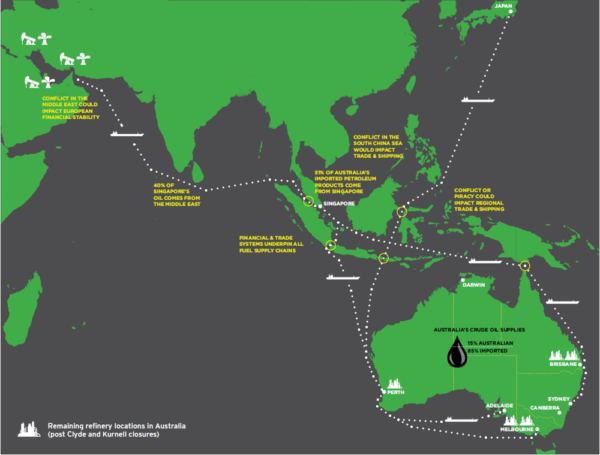
It’s been obvious for a long time that our position in Australia is rather precarious when it comes to our reliance on oil. The drone attacks on the Saudi oil fields brought this point into sharp focus over the past few days.
We rely on foreign liquid fuel imports for 85% of our needs (and climbing). Our refining capacity is also dwindling and it’s estimated that by 2030 there will simply be no refining capacity in Australia at all.
Disruption to oil supply through war, environmental catastrophe or financial meltdown are factors that would leave Australia in a very precarious position as we have a mere few weeks supply despite having obligations as an IEA country to hold 90 days.
This lack of supply was detailed by Air Vice-Marshall John Blackburn back in 2013 in the first of two reports on Australia’s Liquid Fuel Security.
The reports were commissioned by the NRMA. They illustrate the serious situation we would find ourselves in with a disruption to supply.
In essence Australia would come to a standstill within weeks or to quote from the report:
Dry goods could run out within nine days;
Chilled and frozen goods could run out within seven days;
Retail pharmacy supplies could run out within seven days;
Hospital pharmacy supplies could run out within three days; and
Fuel available to the public could run out within three days.
It would be reasonable to think our political masters would have acted swiftly and decisively to beef up reserves based on the report’s findings. Of course making that assumption would adorn our political class with a sense of rationale and intelligence that is clearly beyond their collective abilities. To put it bluntly they have sat on their asses and done virtually nothing to increase reserves or wean us off our addiction to oil.
The drone attacks on the Saudi oilfields have revealed how cheaply and easily oil production can be disrupted. With this backdrop to our current world situation wouldn’t it make sense for Australia to be energy independent with a change from an oil based transport fleet to one that can be powered by local energy sources? Is that too simplistic to suggest or is it as John Cleese may have put it, ‘stating the bleeding obvious’.
The benefits of course would be all that money that currently flows out of the country to procure oil (around $30 billion annually) would be diverted to local Australian energy, creating Australian infrastructure and jobs while making the country more resilient and secure from global supply threats. The added bonuses would be a reduction in health costs associated with vehicle exhaust pollution (around $4 billion annually) the elimination of premature deaths caused by vehicle exhaust (estimated at around 1700 annually) and a reduction in CO2 emissions.
The internal combustion engine is a miracle of technology that has served us usefully in the past. It no longer serves us well. It creates liabilities in energy security, energy independence, public health, balance of trade figures and emissions levels.
The move to EVs is inexorable with every major auto manufacturer committed to an electric future. We are already behind most of the developed world in implementing strategies for this inevitability. Perhaps the wake-up call from the Middle East will help focus the attention this critical vulnerability demands.

I couldn’t agree with you more. I am very disappointed at how long the move away from fossil fuels is taking!
Well said Leo. The convergence of PV with EVs is so synergistic environmentally and economically. Can be achieved on a private level and at a much wider systems level with virtually no back end costs that you get with fossil fuel lock-in. Huge benefits to society the economy and security. Current federal laggards yell ‘freedom’ but want you locked into the hugely inefficient fossil fuel business model. FREEDOM from fossil fuel lock-in I say.